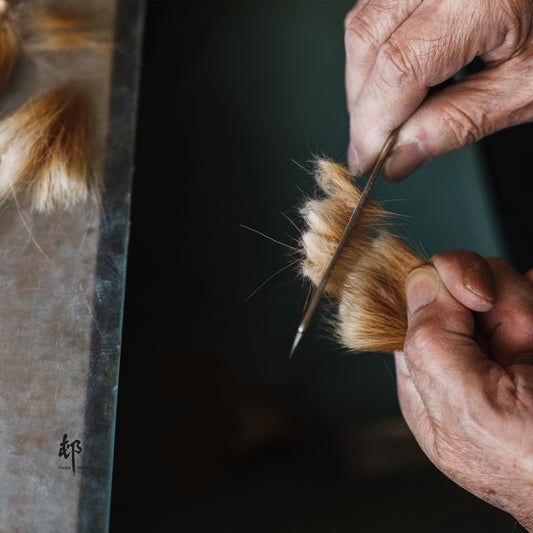墨 sumi ink categories
Solid sumi Ink is made from three primary ingredients: soot, glue (nikawa), and fragrances. The process involves combining soot with glue, adding fragrances, and then kneading the mixture before placing it into wooden molds to dry.
Sumi ink can be broadly categorized into three types based on the type of soot used:
1. Pine Soot Ink (shoen boku): Made from the soot generated by burning pine branches or bark. Dark ink exhibits a subdued matte color, while light ink features a transparent and luminous shade providing a fine-grained three-dimensional effect. It is said that as it ages, the color shifts from black tones to blue tones.
2. Oil Soot Ink (yuen boku): Created from the soot produced by burning vegetable oils such as rapeseed oil. Dark ink presents a glossy and deep black color with a sense of depth. The color may vary depending on the type of vegetable oil used. Light ink, on the other hand, has a faintly brown hue, providing a fine-grained three-dimensional effect.
3. Other Types: Made from burning materials such as mineral oil and carbon black. This type of ink is relatively economical and tends to darken quickly, offering a cost-effective option.
In addition to these traditional sumi inks, recently, colorful sumi inks have emerged and gained popularity. The trailblazer behind this trend is Mr. Masao Horiike, the sole artisan in Japan still producing pine soot, the key ingredient of sumi ink. After being featured and gaining popularity in the book 'Gokujouhin in the Study' (published by Shogakukan Bunko), he experienced a significant breakthrough on the online shopping site of KATEIGAHO, one of the prestigious magazines. Since then, he has continued to expand his product line as the SAIEMBOKU series, introducing various colors, and now the color variations exceed 40.
About solid Sumi Inkstick and liquid sumi ink
The time spent grinding ink is not just a physical act; it is also a crucial time for aligning your thoughts.
However, in the mid-Meiji period, inksticks were developed to encourage a more casual engagement with calligraphy. Since then, responding to people's needs, inksticks continue to be popular.
While it is meaningful in terms of time efficiency, especially in the busy modern era, and we do not deny its merits in that aspect, solid sumi ink provides various advantages besides being gentle on tools like brushes and inkstones (meaning less damage to your brushes or inkstones). At rimpamura, we recommend solid sumi ink.
Expressiveness: Solid sumi ink is ground on an inkstone, and this process makes a significant difference. The characteristics of the 'hoho' (ripples) play a role similar to that of the teeth when grinding the sumi ink. As a result, the created ink may have particles ranging from fine to coarse. The depth and three-dimensionality in monochromatic sumi-e paintings are achieved through this broad spectrum of particles.
Color: From an expressive standpoint, a decisive difference between liquid sumi ink and solid sumi ink lies in the fact that commercially available liquid sumi ink does not become darker than its inherent color. A more intense and powerful dark sumi ink can only be achieved with solid sumi ink. Solid sumi ink excels, particularly in portraying the strength and intensity of features like animal eyes. The strength of expression is where solid sumi ink shines.
what's new
View all-

Maki Fude (cored brushes) vs Suihitsu (non-core...
A Makifude has Japanese paper wrapped around its core; therefore, only about one-third of the bristles on a Makifude brush are exposed for use, while the bristles of a Suihitsu...
Maki Fude (cored brushes) vs Suihitsu (non-core...
A Makifude has Japanese paper wrapped around its core; therefore, only about one-third of the bristles on a Makifude brush are exposed for use, while the bristles of a Suihitsu...
-

Two different ways of making brushes
Fude making has been practiced throughout Japan for centuries, and while the manufacturing methods can vary somewhat depending on the region and shokunin, they can be broadly categorized into two...
Two different ways of making brushes
Fude making has been practiced throughout Japan for centuries, and while the manufacturing methods can vary somewhat depending on the region and shokunin, they can be broadly categorized into two...
-

Season of Sumi making is over this year. Sumi i...
The production of sumi ink takes place during winter. This is because one of the raw materials for sumi, Nikawa glue, may not solidify or may even rot when it...
Season of Sumi making is over this year. Sumi i...
The production of sumi ink takes place during winter. This is because one of the raw materials for sumi, Nikawa glue, may not solidify or may even rot when it...
-

Yoichi Hieda awarded at the 47th Yamaguchi Trad...
It is our great pleasure to announce that Yoichi Hieda is awarded the "Japan Crafts Association Yamaguchi Branch Director's Award", the equivalent of the first prize, at the 47th Yamaguchi...
Yoichi Hieda awarded at the 47th Yamaguchi Trad...
It is our great pleasure to announce that Yoichi Hieda is awarded the "Japan Crafts Association Yamaguchi Branch Director's Award", the equivalent of the first prize, at the 47th Yamaguchi...




